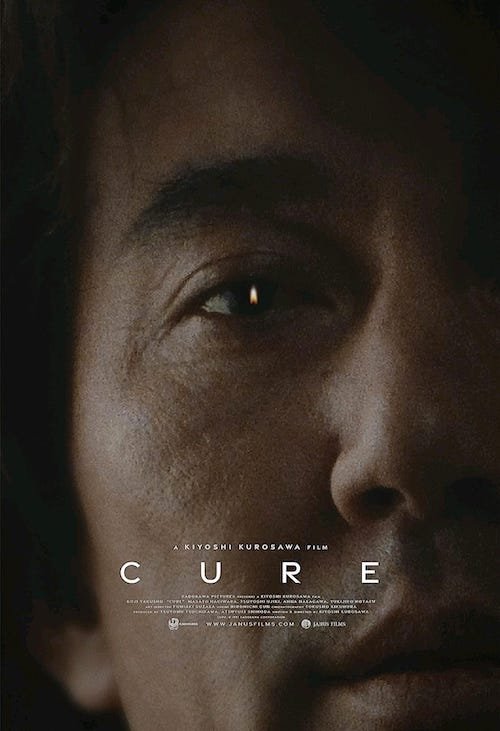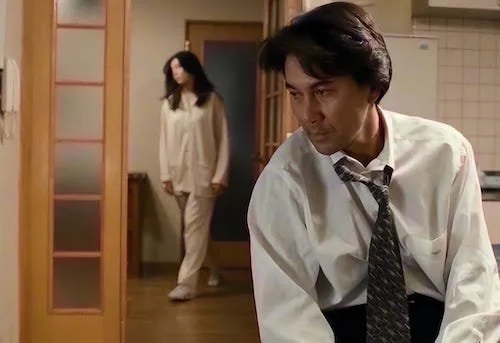Cure
Written by Octavio Carbajal González
"He who fights with monsters should be careful lest he thereby become a monster. And if you gaze long enough into an abyss, the abyss will gaze back into you."
—Friedrich Nietzsche
Kiyoshi Kurosawa, a renowned figure in Japanese cinema, is celebrated for his masterful blending of psychological horror, thriller, and drama. His filmography, including works like Charisma (1999), Pulse (2001) and Tokyo Sonata (2008), often explores themes of existential dread, societal alienation, and the fragility of human connections. Released in 1997, at the dawn of the J-horror era, Kurosawa’s masterpiece Cure (1997) stands alongside the famous and widely celebrated works of Hideo Nakata's Ringu (1998), Takashi Shimizu's Ju-On (2002), and Takashi Miike's Audition (1999), all of whom introduced Japanese horror to Western audiences. While Ringu and Ju-On draw from traditional Japanese ghost stories and folklore, Kurosawa’s film diverges with its absence of ghosts or excessive graphic violence. Instead, it is subtle, quiet, modern yet timeless. Unlike the sensational horrors of its contemporaries, Cure delves into the unspoken evils of modern society and their human origins.
Detective Kenichi Takabe (Koji Yakusho) is at the center of the film. Struggling with his role both as a detective and as a husband, he feels increasingly disconnected from his surroundings. His wife, Fumie (Anna Nakagawa), is undergoing psychological treatment, and her constant compulsive behaviors have created a domestic disarray inside the house. Fumie's mental state collides with Takabe's inner turmoil, since he's about to start investigating a case that might change his life forever. Takabe is aided in this investigation by his colleague, Sakuma (Tsuyoshi Ujiki), a psychiatrist who provides rational insights into the cases they are dealing with. Together, they delve into a series of brutal murders in Tokyo, all marked by an "X" carved into the victims' necks. The murderers, seemingly ordinary individuals with no violent pasts, cannot recall committing the crimes. These murders are not committed in madness or passion, but in moments of unsettling clarity.
Kurosawa employs a restrained visual style, using long takes and minimal camera movement. This creates a sense of unease and allows the tension to build slowly.
The investigation soon leads to the true antagonist, Mamiya (Masato Hagiwara), a young man with an aura of enigmatic calm. He hypnotizes others into committing murder without ever resorting to threats or violence himself. Mamiya's background as a gifted psychology student provides the only glimpse into his past. Though more of a cipher than a fully fleshed-out character, Mamiya's quiet charisma lulls people into a trance-like state, stripping away their inhibitions. His calm demeanor stands in stark contrast to the verbose and grandiose villains of Hollywood thrillers like The Silence of the Lambs (1991) and Se7en (1995). In Cure, there are no elaborate justifications for evil deeds. Instead, violence is portrayed as a contagion, an endless cycle passed from person to person. Mamiya’s soft-spoken inquiry, “tell me about yourself,” taps into a universal frustration: the desire to be truly listened and loved. His calm conversations unearth the violent impulses simmering beneath the surface of ordinary lives, revealing the latent anger and violence within.
The theories of German physician Franz Mesmer significantly influence the film, particularly through the character of Mamiya. Mesmer, best known for his theory of "animal magnetism," proposed that a universal natural force is possessed by all living beings, including humans, animals, and plants. His work laid the groundwork for modern hypnosis and the study of psychosomatic disorders. Mesmer's ideas about unseen forces controlling human behavior resonate with Mamiya's hypnotic power to compel ordinary individuals to commit murder. This concept is intricately woven into the plot, as Mamiya's interrogation technique—repeatedly asking "Who are you?"—echoes Mesmer's belief in the profound impact of suggestion on the subconscious mind. Through Mamiya's manipulation, the film explores the terrifying potential for external forces to erode personal identity and free will, driving the central narrative of psychological disintegration.
The narrative of Cure is non-linear and fragmented, reflecting the fractured mental states of the characters. Flashbacks and disjointed sequences create a sense of confusion and mystery.
Kurosawa's minimalist visual approach amplifies the film's unsettling atmosphere. Long, static shots create a sense of claustrophobia and tension, while the urban landscape is depicted as cold and indifferent. The use of empty spaces and lingering shots emphasizes the void within the characters and their environments, the sound design is minimalist but highly effective. Ambient sounds, such as the hum of fluorescent lights or distant traffic, contribute to the film's eerie atmosphere. The lack of a traditional score allows the natural sounds to take prominence, creating an immersive and unsettling auditory experience. In general, the visuals and sounds ask profound questions about the nature of evil and the shallowness of contemporary human relationships. Mamiya embodies an inexplicable form of evil, devoid of clear motives, exposing the inherent darkness within others. This challenges the notion that evil can be rationalized or controlled, suggesting it is an intrinsic part of human nature. The film also explores the fragility of identity. Mamiya's hypnotic influence strips away social masks, revealing primal urges. As Takabe grapples increasingly with the influence of his elusive and enigmatic suspect, the movie gradually transforms into a social horror tale. Initially a steadfast detective, Takabe unravels as he confronts the possibility of his own susceptibility to Mamiya's influence. The line between sanity and madness becomes increasingly blurred.
In modern cinema, Cure stands as a testament to the power of ambiguity and the enduring appeal of psychological horror. Its exploration of identity, control, and the nature of evil resonates with timeless relevance, ensuring its place as a film that continues to captivate and disturb audiences worldwide.
Octavio is a passionate cinema enthusiast from Mexico City, he mostly enjoys watching arthouse films from all over the globe. His reviews are published on "Vinyl Writers" (www.vinylwriters.com).








